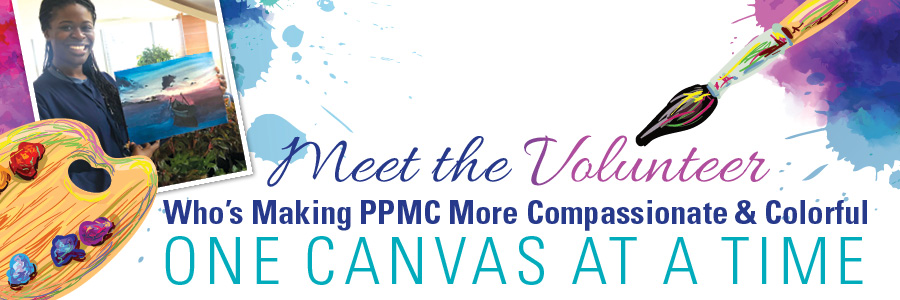
Whether she’s sharing her megawatt smile with overwhelmed patients or her calming spirit with stressed visitors, Sophia Otasowie loves sharing her talents, interests, and time with others. As if finishing her senior year at the University of Pennsylvania, selling hand-painted graduation cap tops through her celebrity-endorsed Etsy shop (then donating the profits to fund students’ college educations in Nigeria), and staying active in her church weren’t enough, Otasowie also joined Penn Presbyterian Medical Center’s volunteer program in order to combine her passions — science, art, and giving back — in a meaningful way.
Earlier this year, Otasowie and Volunteer Services coordinator Naimah Cann developed a volunteer-led art program that engages patients and helps them process their thoughts and express their feelings in a new way. In only a few short months, Otasowie and her basket of art supplies have been able to share some light and color with the patients, visitors, and even staff who need it most.
______________________________________________________
“Sophia’s spirit and love of art have given our patients an outlet for artistic expression. She designed the painting in my office, and I will cherish it forever as a reminder of what she has brought to our volunteer program — purpose and a love of making things beautiful by giving back.” — Naimah Cann, Volunteer Services Coordinator
______________________________________________________
Q: How did you get involved with PPMC’s volunteer team?
A: I’m a biology major with an interest in pre-med, so I knew getting experience in the hospital would be a valuable opportunity, both in terms of working directly with patients and getting a behind-the-scenes look of the clinical side. I started volunteering on Cupp 3, and Benjamin D’Souza, MD, [a cardiologist] agreed to let me shadow him. I followed him on rounds, watched his team in the cath lab, and stood this close to a heart surgery! I’m still considering many paths — CNA certification, medical school, a master’s in medical illustration — but my experience at PPMC has really encouraged me to pursue medicine in some way. When Naimah and I figured out that we could integrate art into my volunteer work, it was like everything came full circle.
Q: Tell me about the development of the art program.
A: Naimah and I started researching the viability of art therapy in hospitals, and we found that both seeing and making art can have huge effects on a patient’s mood and the way they recover. I also learned that the color green really changes the human perspective. It makes us feel less trapped and more relaxed — think about the green spaces that make urban places like Philadelphia feel more open. So when PPMC agreed to fund the program, I decided to stick to natural paintings. Jellyfish are a favorite, but I also do trees, landscapes, oceans — things that bring some light and life into a clinical space.
Q: What is an average art session like?
A: We rolled out the program with weekly paint sessions in the cafeteria. People would come up and watch or talk to me as I painted, and then we raffled off the finished canvases. I still visit the cafeteria, but now I mostly work on patient floors like in the Center for Continuing Care. Many patients there are recovering from painful surgeries or falls and stuck waiting for physical therapy. Engaging them in an activity and in conversation can get their focus off the pain for a little while, so if they’re interested, I give them a postcard-sized canvas, and we paint something together and just talk. Most haven’t painted since elementary school, but I always tell them to sign the back and to remember me if one day they become a famous artist!
Q: How have patients reacted? Have there been any highlights or memorable moments?
A: The response has been awesome, and I’ve met some really wonderful people and had some great conversations. I was working on a landscape with a patient and her sister, and as we were adding mountains, one sister asked if she could do her own thing. The other looked over, saw she was adding water, and decided to one-up her by adding waterfalls. The rest of the visit became this back-and-forth competition, and it was hilarious. But even my most difficult visit was rewarding. A patient kept saying it was too hard, she wasn’t cut out for this, I must have given her the bad brushes…. But when we finished, she said the most profound thing. After all her insistence that she wasn’t an artist, she said, “You know what? This was really nice. It made me forget the pain.” Then she asked where she could buy her own art supplies.